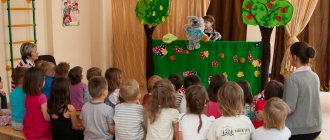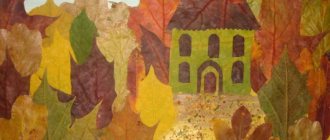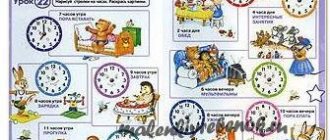Anatomy for kids: geometric shapes
The simplest instructions that will be understandable to children of primary and secondary kindergarten age. The work should be done under the supervision of an adult, who will voice each part of the body, show it to the baby himself and supervise the entire process of creating the craft. The more elements, the more difficult the task will be, so you should start with the simplest models.
From simple geometric shapes you can make a full-fledged postcard, the main character of which will be any family member.
Bright and cheerful images will certainly appeal to children of primary preschool age.
For those who are older, a unique mosaic composition is suitable. For example, from the proposed stencil you can make blanks for a future picture.
Invite your child to assemble a little man from the resulting elements, gluing them in a certain sequence on the base sheet.
The benefits of simple materials for child development
The faster and more confidently technological progress automates our lives, tempts us with a multitude of devices and millions of different assistant gadgets, the more we want to surround ourselves with something natural, to create something worthwhile with our own hands. The dream of all modern parents is to find an alternative to computer games and tablets for the full development of children. And she is!
An excellent, affordable and 100% effective assistant in a child’s development are simple materials. Do-it-yourself crafts from what is in every home will help distract children from the TV and laptop, replace communication with “electronic friends”, and immerse them in an exciting creative process.
Using simple materials, old magazines, pasta and various cereals, plasticine, modeling dough, paper, cardboard, you can create real masterpieces - gifts, cards, jewelry, toys and even home decor.
It’s just important not to be afraid and find time to create together with your child. You can generate your own ideas and implement them, or you can use ready-made templates, which saves time and guarantees excellent results.
We are sure that everything will work out for you!
Secrets of the perfect applique: cut, glue, play
The benefits of simple materials
- Scientists say that the best helpers for enhancing the intellectual, emotional, social and physical development of a child in the first years of life are the simplest objects and things - paper, clay, cubes, water and paints.
- By making crafts with his own hands from the most available materials, the child learns to interact with the people around him, express his point of view and respect the work of others.
- As for physical development, at 3-4 years old, large muscles in children predominate over small muscles. While playing with sand, the baby digs on his knees, tries to use different toys that he needs to reach, transfers sand from one place to another, thus strengthening the muscles of the torso, arms and legs, developing large muscles, coordination of movements and balance.
- The simplest materials during creative activities with a child contribute to the development of fine motor skills. While drawing and coloring, the baby holds a pencil in his hands and moves it across the paper. This pastime develops hand-eye coordination, makes it clear which hand is dominant, and strengthens the skill of drawing elementary figures, lines, and dots.
- Finger paintings and paper crafts help strengthen children's hands and develop independent finger movement. During sculpting and applique, the muscles that help little fidgets hold a pencil and pen are strengthened.
- Using simple materials in children's creativity provides an endless number of ideas and opportunities for the child's intellectual, social, emotional and physical development. It is important that their cost is low, but the benefits are immeasurable.
- A child’s creativity is always a surprise both for his parents and for himself. In order to fully develop imaginative thinking and imagination in children, parents need to take such activities responsibly, be nearby, encourage, suggest, motivate and encourage!
It is known that paper is the most affordable and widespread material for DIY crafts. For many years, humanity has been coming up with more and more variations of transforming an ordinary sheet of paper into a work of art. For children, this is the most attractive means of creativity. Coloring books, origami, postcards, appliqués, animal models, transport models, home decor and more - the paper world is simply diverse!
Canon the ideal product for children's development and stimulation of creativity - Canon Creative Park. There are blanks for creating applications, postcards, commemorative calendars and even photo frames that you will definitely want to make. Moreover, not only for the child, but also for the parents!
In addition, such incredible 3D construction models are available on the site that you can create an entire city, with characters, heroes, animals, vehicles, and then come up with many plots for games with everything that was very painstakingly created with your own hands. And all this is made of paper. You can decide for yourself what size your craft will be and what density it will be by simply downloading and printing the template completely free of charge.
All paper craft templates are available HERE!
Expert opinion
Anna Trukhan
Practicing crisis psychologist. President of ICDP Ukr aine. Member of the Board of Directors of the National Psychological Association. Trainer of the International Child Development Program, founder and deputy head of the NGO “Association of Child and Family Psychologists of Ukraine”.
One of the indicators of intellectual readiness for schooling is the level of development of fine motor skills and coordination of movements of the baby’s fingers.
Therefore, it is very important when preparing a preschooler to pay special attention to the development of fine motor skills. After all, it is finger training that accelerates the process of functional maturation of the brain.
Typically, a child who has a high level of development of fine motor skills can reason logically, has sufficiently developed memory and attention, and coherent speech.
Therefore, long before entering school, work on developing fine motor skills should begin. It is important to develop mechanisms that will help a child master writing skills.
At the age of 6 years, a child undergoes a whole evolution in the development of fine motor skills, coordination of movements, thinking and creative processes.
And already from 6 to 12 years old, the acquired skills are consolidated, and the child’s abilities for a certain type of activity are revealed.
Preschool children, having mastered drawing and modeling, strive to master new skills. They show a strong interest in working with scissors, making appliques and origami.
Children love activities during which they learn new skills and the results of their creativity can be seen, examined, and touched. Children especially like it when they can play with what they have made.
Man in motion: people in different poses
The main elements for implementing this technique are shapes: squares, rectangles and wide stripes. Therefore, this technique partially relates to geometric appliqué. The easiest way is to prepare blanks for the first trial work from a notebook sheet in a box. There are already markings there, you just need to cut out the necessary shapes.
As a lesson, explain how certain parts of the body are depicted during movement. Why does this happen and for what purpose? From a number of similar works on a specific topic, you can make an entertaining panel dedicated to sports, family relationships or friends.
On the topic: methodological developments, presentations and notes
Often, not everyone in their preschool educational institutions can purchase the necessary equipment; unfortunately, insufficient funding in our rural areas is progressing. Maybe someone will find my ideas on sports events useful.
Prevention of childhood injuries is one of the most important tasks of modern society, which must be achieved primarily by observing safety precautions in physical education classes.
The didactic game develops visual attention and logical thinking. It will also help consolidate children’s knowledge about different sports, athletes, and sports attributes.
Presentation of work experience.
The material is intended for children of senior preschool age. Can be used in educational activities and in organizing leisure time.
SOD summary for the production of collective work using the 3D appliqué technique “Sport - health, sport - game”.
Tatyana Titova Summary of SOD for the production of collective work using the technique of volumetric application “Sport - health, sport - game”







